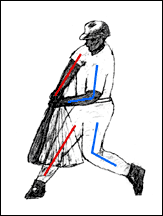| |  | - |
|

Rethinking Old Baseball Hitting Theories
Get Your Arms Extended
Full extension of the arms and hitting power seem to be synonymous to most batting authorities. Invariably, when a long home run is hit during a game, the commentator will declare; "Boy, he really got his arms extended on that one." Also, sports photographers apparently think that a batter with both arms fully extended is the only position worthy of being photographed. This is the position they will invariably use whenever home run power is the theme of the picture. Never mind the fact that when that frame was shot the ball had long since left the bat and was soaring somewhere over the shortstop's head. This would still be portrayed as the position responsible for the power in the swing.

I think most coaches would agree that the lead arm will be fairly extended as the bat makes contact with the ball. The question then becomes, what is the timing of the extension of the top hand and arm? --- Extension of the back arm at contact is mainly determined by the amount of torque applied at initiation and rotation of the hips and shoulders. If the shoulders and hips have fully rotated, bellybutton and chest are facing the pitcher, the back arm will have extended very little at contact.
But, if on the other hand, there is much less rotation, say the chest and bellybutton are more facing the second baseman, then the back arm will need to be extended further. Therefore, the only time the back arm of a great hitter will near full extension at contact is when he is fooled by the pitch and just waves at the ball or is swinging at a ball on outside part of the plate.
To reach outside pitches, the rotation of the shoulders must slow to allow the lead arm to cast out farther to get the meat of the bat on the ball. This will also cause the back arm to be more extended at contact. On pitches from the middle-in portion of the plate the back arm will NOT be even close to full extensions. It will be in the form of the classic "L" position as shown in the drawing. As illustrated, the back arm is far from being fully extended at contact. After the ball is well on it's way, momentum and centrifugal force of the bat will "pull" the back arm to full extension.
At contact, both the lead arm and leg are straight. While both the back leg and arm form the "classic L". The hips and shoulders will have fully rotated. The lead shoulder is now pulling back toward the catcher. This is the power position of the great hitter at contact.
|

![]()